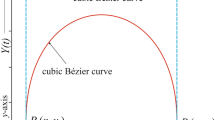Abstract
The geometry of the joint pattern in the Aywaille area (Ardennes, Belgium) is analysed with statistical methods. The orientations of intersecting joint-planes were recorded together with the bedding-plane. Four principal sets have been distinguished. These sets are related orthogonally to the bedding-plane and geometrically to the regional fold structure. All sets are considered to represent tensional structures, formed in a single period after the folding. The joint pattern is compared with a model given byPrice (1966). It is concluded that this model, describing the generation of joints in relation with folding, cannot explain completely the formation of the joint-sets under consideration here.
Zusammenfassung
Die Geometrie des Klutgefüges im Aywaille Gebiet (Ardennen, Belgien) wurde mit statistischen Methoden analysiert. Die Orientierungen sich schneidender Kluften und der Schichtflächen wurden erfaßt und vier Hauptkluftscharen unterschieden. Diese Scharen durchsetzen die Schichtflächen im rechten Winkel und in Symmetrie zur Faltenachse. Alle Klüfte werden als gleichzeitig nach der Faltung entstandene Zugklüfte gedeutet, Das Kluftgefüge wird mit einem vonPrice (1966) angegebenen Modell für das Entstehen von Klüften nach der Faltung verglichen. Es ergibt sich, daß dieses Modell nicht zur vollständigen Erklärung der betrachten Kluftscharen ausreicht.
Résumé
La géométrie du régime de fractures dans la région d'Aywaille (Ardennes, Belgique) est analysée par des méthodes statistiques. Les orientations des intersections des plans de fractures ont été enregistrées en inculant le plan de stratification. On a distingué quatre ensembles principaux. Ces ensembles sont reliés orthogonalement au plan de stratification et géométriquement au plissement régional. On considére que tous ces ensembles représentent des structures de traction, formées au cours d'une mème période postérieure au plissement. Ce type de fractures peut-être comparé au modèle donné par Price (1966). On peut en conclure que ce modèle, décrivant la formation des fractures associées au plissement, ne peut pas expliquer complètement le développement des ensembles de fractures étudiés ici.
Краткое содержание
С помщью статистичес кого метода удалось у становить расположение пересе кающихся трещин, их ориентацию в пространстве и выде лить 4 их группы (район Aywaille, Ardenne, Belgium). Эти группы трещин прорезают плоскость слоев под прямым угло м и симметричны к оси с кладок. Все трещины рассматрива ют, как появившиеся одно временно после складкообразования в результате растяжения. Структур у трещин сравнили с мо делью Price, составленной (1966) для понимания разви тия трещин после горообразования. Но э та модель не дает полного объяс нения появления набл юдающихся групп трещин.
Similar content being viewed by others
References
Badgley, P. G.: Structural and tectonic principles. Harper & Row, New York, 521 p. 1965.
Beach, A.: The geometry of en-echelon vein arrays. Tectonophysics,28, 245–263, 1975.
Currie, J. B. &Reik, G. A.: A method of distinguishing regional directions of jointing and identifying joint sets associated with individual geologic structures. Can. J. Earth Sci.,14, 1211–1228, 1977.
Ek, C. M.: Les influences structurales sur la morphologie de la grotte de Remouchamps (Belgique). Extraits. Ann. Soc. Geol. Belg.,93, II, 1970.
Fourmarier, P.: Prodrome d'une description géologique de la Belgique. Mem. Soc. Geol. Belg., 826 p, 1954.
-: Carte géologique de la Belgique 1∶25.000; Feuille Louveigné-Spa no. 148, 1958.
Gash, P. J. S.: A study of surfaces features relating to brittle and semi-brittle fracture. Tectonophysics,12, 349–391, 1971.
Langenberg, C. W., Rondeel, H. E. &Charlesworth, H. A. K.: A structural study in the Belgian Ardennes with sections constructed using computer-based models. Geol. & Mijnb.,56 (2), p. 145–154, 1977.
Mäkel, G. H. &Verburg, J. A.: Determining axes of conical folds and similar structures using computer-based methods, in prep.
Mardia, K. V.: Statistics of directional data. Academic Press, London, 357 p, 1972.
Montjoie, A.: Géologie de l'intérieur au site de la centrale de pompage de Coo (Belgique). XXIII Int. Geol. Congr.,12, p. 219–227, 1968.
Price, N. J.: Fault and joint development in brittle and semi-brittle rock. Pergamon Press, New York, 176 p, 1966.
Ramsay, J. G.: Folding and fracturing of rocks. McGraw Hill Book Co., New York, 568 p, 1967.
Roberts, J. C.: Jointing and minor tectonics of the south Gower Peninsula between Mumbles and Rhossilli Bay, South Wales. Geol. J.,14, 1–13, 1979.
Ruhland, M.: Methode d'étude de la fracturation naturelle des roches associée a divers modèles structureaux. Sci. Geol. Bull.,26, 2–3, p. 91–113, 1973.
Stearns, D. W. &Friedman, M.: Reservoirs in fractured rocks. In: Kling, R. E., ed. Stratigraphic oil and gas fields: Classification, exploration methods and case histories. Am. Assoc. Petroleum Geologists. Mem.16, 82–106, 1972.
Till, R.: Statistical methods for the earth scientist, an introduction. MacMillan Press, London, 154 p, 1974.
Author information
Authors and Affiliations
Rights and permissions
About this article
Cite this article
Maier, G., Mäkel, G.H. The geometry of the joint pattern and its relation with fold structures in the Aywaille area (Ardennes, Belgium). Geol Rundsch 71, 603–616 (1982). https://doi.org/10.1007/BF01822385
Issue Date:
DOI: https://doi.org/10.1007/BF01822385




